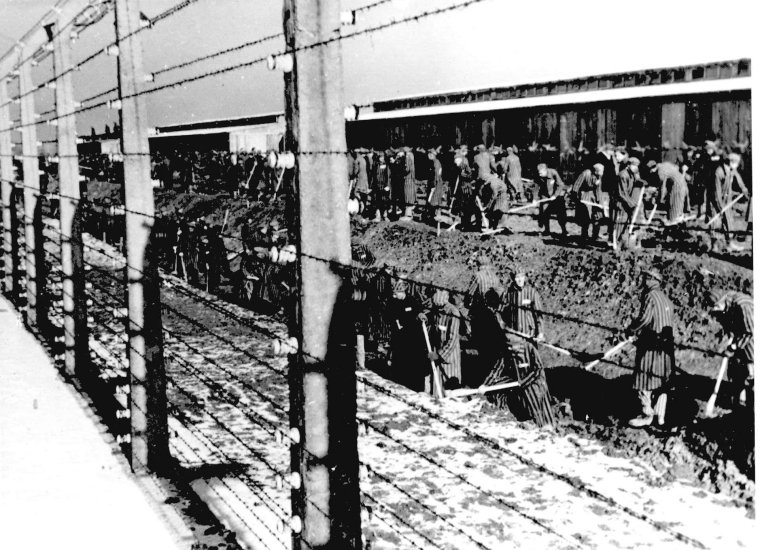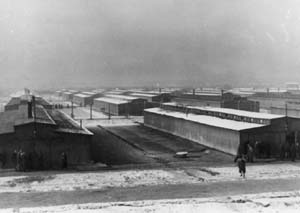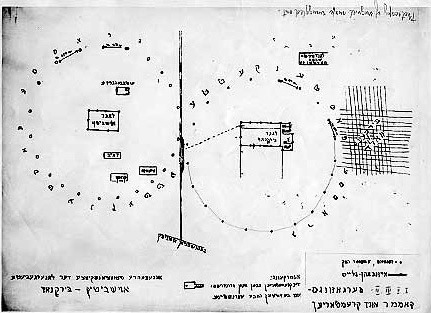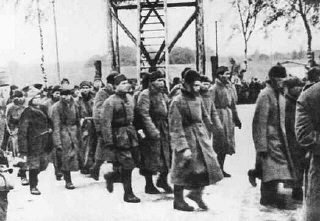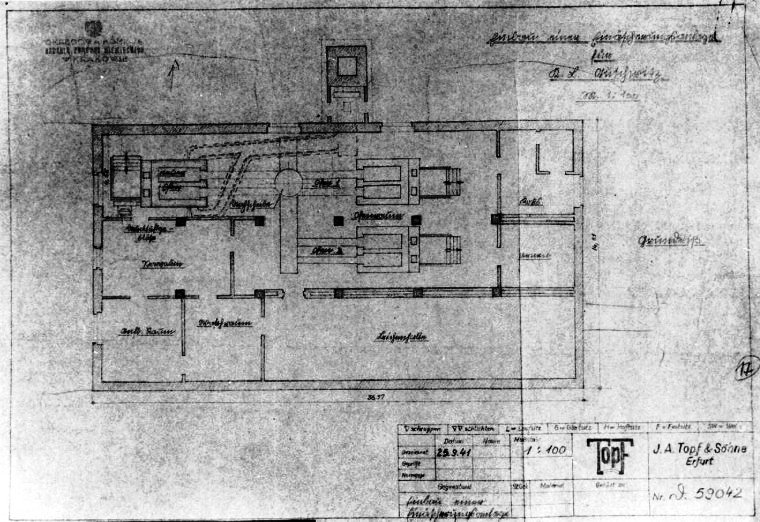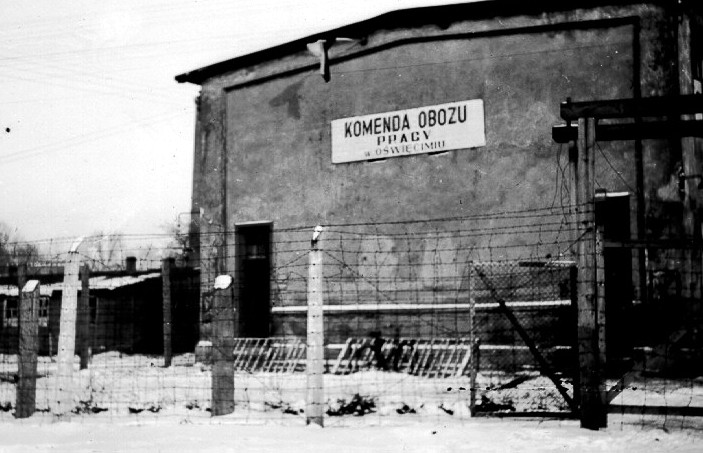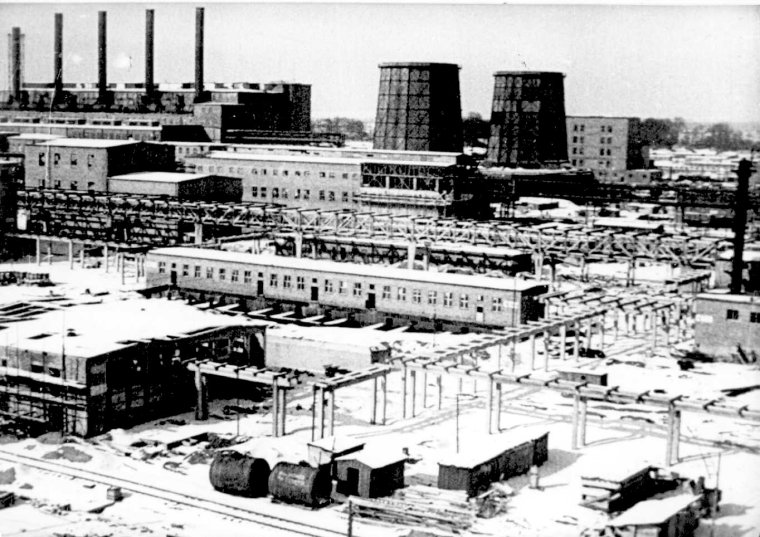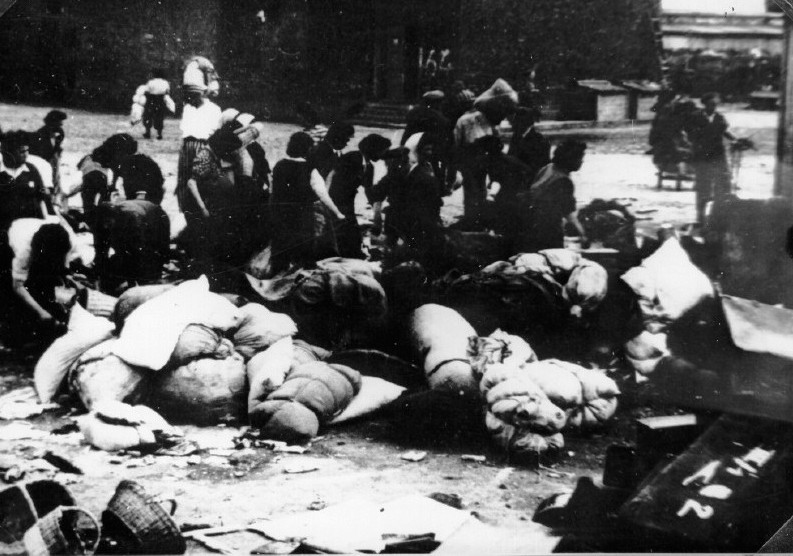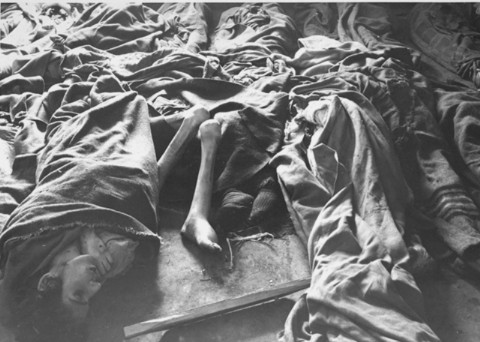Holocaust Education & Archive Research Team |
|
Other Camps
Key Nazi personalities in the Camp System The Labor & Extermination Camps
Auschwitz/Birkenau Jasenovac Klooga Majdanek Plaszow The Labor Camps
Trawniki
Concentration Camps
Transit Camps |
|||||
The Auschwitz Protocol The Vrba-Wetzler Report
[Transcribed from the original O.S.I report of the US Department of Justice & the War Refugee Board Archives] (Photos added to enhance the text)
...Part III
The camp of BIRKENAU consists of three building areas. At present only sections I and II are guarded by the inner chain of sentry posts, whereas section III is still under construction and uninhabited.
At the time of our departure from the camp (the beginning of April, 1944), the following categories of prisoners were in BIRKENAU: SECTION I (Women's Concentration Camp)
Slav. Jews Other Jews Aryans 1a and 1b app.300 app. 7,000 app.6,OOO
Remarks : In addition to the 300 Slovak Jewish girls, app. 100 are employed in the administration building of AUSCHWITZ
SECTION II (Men's Concentration Camp)
Slav. Jews Other Jews Aryans 2a quarantine camp 2 app.200 app.800
Remarks : One of the two Slovak Jews is Dr. Andreas MULLER from Podolinec (Block Eldest).
Slav. Jews Other Jews Aryans 2b Jews from THERESIENSTADT - app. 3,500 With a six month quarantine.
2c -presently uninhabited.
2d "Stammlager" 58 app 4,000 app 6,000
The Gypsy Camp -app 4,500 This is the reminder of some 16,000 gypsies. They are not used for work and die off rapidly.
No. 36,832 Walter SPITZER, block eldest from NEMSOVA, came to LUBLIN from BIRKENAU.
No. 32,407 Ludwig EISENSTADTER, tattooist from KREMPACHY.
The internal administration of the camp of BIRKENAU is run by specially selected prisoners. The "blocks" are not inhabited according to nationalities but rather according to working categories. Each block is supervised by a staff of five, i.e., a block eldest, a block recorder, a male nurse, and two attendants.
The block eldest He wears an arm band with the number of his block, and is responsible for order there. He has power over life and death. Until February, 1944, nearly 50 percent of the block eldest's were Jews but this was stopped by an order of BERLIN. They all had o resign with the exception of three Jews who, in spite of this order, were able to keep their posts.
The block recorder
He is the block eldest's right-hand, does all the clerical work keeping the index cards and records. His work is of great responsibility and he has to keep his ledgers with painful exactitude as the index cards only indicate the number and not the name of the prisoners; errors are fatal. For instance, if the recorder has noted down a death by mistake and this often occurs with the unusually high mortality the discrepancy is simply straightened out by killing the bearer of the corresponding number. Corrections are not admitted. The block recorder occupies a key post which is often misused.
Nursing and "room" duties
They consist in keeping the inside of the barracks clean and carrying out small manual jobs in and around the block. Of course there is no question of really taking care of the sick. The camp eldest supervised the whole camp; he is also a prisoner. This post is at present held by:
Franz DANISCH, No. 11,182 a political prisoner, from KONIG-SHUTTE, Upper Silesia. He is undisputed master of the whole camp and has power to nominate or dismiss block eldest's and block recorders, hand out jobs, etc.
Further we have a "chief recorder" whose position is undoubtedly one of the most powerful in the camp. He is in direct contact with camp headquarters, receiving their orders and reporting on all matters. All camp recorders are directly subordinated to him and have to submit all their reports to him. The chief recorder of BIRKENAU is;
Kasimir GORK, No. 31,029, a Pole from WARSAW, a former bank clerk. The supreme control over the blocks lies in the hands of six to eight "block leaders," all SS men. Every night they hold roll call, the result of which is communicated to:
The Camp Leader, "Untersturmfurhrer" SCHWARZHUBER, from the Tyrol. This individual is an alcoholic and a sadist. Over him is the camp commander who also controls AUSCHWITZ where there is a second subordinate camp leader. The camp commander's name is; HOESS.
The Chief of the work squad or group is called the "Capo". During work the "Capo" has full authority over his group of prisoners and not infrequently one of these "Capo's" kills a man working under him, In larger squads there may be several "Capo's" who are then under the orders of a "Capo-in-chief."
At first there were many Jewish "Capos," but an order from BERLIN prohibited their being employed. Supreme control over work is carried out by German specialists.
II. MAJDANEK
ON JUNE 14, 1942 we left NOVAKY, passed ZILINA and arrived at ZWARDON toward 5 o'clock in the evening. We were assembled, counted, and SS men took over our convoy. One of these guards voiced his surprise at the fact we made the journey without water by shouting:
"Those Slovak barbarians, give them no water!"
The journey continued and we reached LUBLIN two days later. Here the following order was issued:
"Those fit for work aged between 15 and 50 are to leave the cars. Children and old people remain." We struggled out of the freight car and discovered that the station was surrounded by Lithuanians in SS uniforms, all armed with automatic pistols. The cars containing the children and old people were immediately closed and the train moved on. We do not know where they went and what happened to them . The SS troop leader in command informed us that we had a long way ahead of us, but that whoever wanted to take his luggage with him could do so. Those who preferred to put it on a truck would certainly receive it later. So some of us dragged along our luggage, whereas others loaded it on the truck.
Behind the town stood a clothing factory called the "Bekleindungswerke." In the courtyard waiting for their noon meal some 1,000 prisoners in dirty striped clothing, obviously Jews, were lined up and the sight of them was none too encouraging. Arriving on a small hill we suddenly sighted the vast barrack camp of MAJDANEK surrounded by a 3-meter-high barbed wire fence.
No sooner had we gone through the entrance gate than I met a prisoner who warned me that all our personal belongings would be taken away. Around us stood Slovak Jews in a wretched condition, their heads shaven, in dirty prison clothes and wooden clogs or simply barefooted, many of them having swollen feet.
They begged us for food and we gave them what we could spare, knowing very well that everything would be confiscated anyway. We were then conducted to the stockroom where we had to leave everything we possessed. At double time we were herded into another barrack where we had to undress, were shaved, and given a shower. After this we were issued convict outfits, wooden clogs and caps.
I was assigned to "working section NO.2" as the whole camp was divided into three such sections separated by wire fences. Section NO.2 was occupied by a number of Slovak and Czech Jews. For two full days we were taught how to remove and put on our caps when we met a German. Then in the pouring rain we practiced roll call for hours.
The barrack accommodations were quite original to say the least. Three long tables (nearly as long as the barrack itself) had been placed one on top of the other. These comprised our "bunks" (4 floors of them, that is ground floor plus the three tables). A small passage was kept open along the walls.
Our food consisted of a fairly thick "soup" early in the morning which had to be eaten with the hands. We got the same soup again at lunch. The evening meal consisted of a brew called "tea," 300 grams of bad bread and some 20 to 30 grams of marmalade or artificial fat of the worst quality. Great importance was attributed during the first few days of the learning of the "camp song." For hours we stood singing:
Working section No. 1 was occupied by Slovak Jews Working section No. 2 was occupied by Slovak and Czech Jews Working section No. 3 was occupied by Partisans Working section No. 4 and 5 was being constructed by the Jews of sections 1 and 2
The Partisans in section III were locked up in their barracks without having to work and their food was thrown at them as if they had been dogs. They died in great numbers in their overcrowded barracks and were shot at the slightest excuse by the guards who did not dare venture too near them.
The "Capo's" were Reich Germans and Czechs; whereas the Germans were brutal, the Czechs helped wherever they could. The camp eldest was a gypsy from SERED by the name of GALBAVY.
A Jewish orchestra leader was forced to conduct from the roof of one of the barracks. This was the occasion of much hilarity among the SS men. During these" concert parties" the SS guards were very generous with blows and physical punishment. A tragic end befell Rabbi ECKSTEIN from SERED who was suffering from dysentery and once came a few minutes too late for the role call. The group leader had him seized and dipped head first into one of the latrines, then poured cold water over him, drew his revolver and shot him.
The crematorium was located between working sections I and II and all the bodies were burned there, With an effective strength of 6,000 to 8,000 men per working section, the mortality was about 30 a day. This figure later increased five and six fold. In other instances 10 to 20 inmates were removed from the sick room, brought to the crematorium and burned, after having been put to death in a manner which I have not been able to find out. This crematorium was electrically heated and the attendants were Russians.
Illnesses increased as a result of the bad food and intolerable living conditions. Serious stomach troubles and a seemingly incurable foot disease spread throughout the camp, The feet of the victims swelled up to the point where they could not walk. More and more of the sick were not being taken to the crematorium and when on June 26, 1942 the number thus treated rose to 70, I decided to take an opportunity which was offered to me and applied for a transfer to AUSCHWITZ.
On June 27, 1942 I discarded my prisoner's outfit and travelled to AUSCHWITZ in civilian clothes. After a journey of 48 hours during which we were cooped up in freight cars without food or water, we arrived III AUSCHWITZ half dead. At the entrance gate the huge poster "Work brings freedom," greeted us. As the courtyard was clean and well kept, and the brick buildings made a good impression after the dirty and primitive barracks of LUBLIN, we thought that the change was for the best.
We were taken to a cellar and received tea and bread. Next day, however, our civilian clothes were taken away, our heads were shaved, and our numbers were tattooed on our forearms in the usual. way. Finally, we were issued a set of prisoner's clothes similar to those we had worn in LUBLIN and were enrolled as "Political Prisoners" in the concentration camp at AUSCHWITZ.
We were billeted in "Block 17" and slept on the floor. In an adjoining row of buildings separated from ours by a high wall, the Jewish girls from Slovakia, who had been brought there in March and April of 1942 were quartered. We worked in the huge "BUNA" plant to which we were herded every morning about 3 a.m. At midday our food consisted of potato or turnip soup and in the evening we received some bread. During work we were terribly mistreated. As our working place was situated outside the large chain of sentry posts, it was divided into small sectors of 10 x 10 meters, each guarded by an SS man, Whoever stepped outside these squares during working hours was immediately shot without warning for having "attempted to escape." Often it happened that out of pure spite an SS man would order a prisoner to fetch some given object outside his square. If he followed the order, he was shot for having left his assigned place.
The way to and from work had to be covered at a brisk military trot; anyone falling out of line was shot. On my arrival about 3,000 people, of whom 2,000 were Slovak Jews, were working on this emplacement. Very few could bear the strain und although escape seemed hopeless, attempts were made every day. The result was several hangings a week.
After a number of weeks of painful work at the "BUNA" plant a terrible typhus epidemic broke out. The weaker prisoners died in hundreds. An immediate quarantine was ordered and work at the "BUNA" stopped. Those still alive were sent, at the end of July, 1942, to the gravel pit but there work was even still more strenuous. We were in such a state of weakness that, even in trying to do our best, we could not satisfy the overseers. Most of us got swollen feet. Due to our inability to perform the heavy work demanded on us our squad was accused of being lazy and disorderly. Soon after a medical commission inspected all of us; the carried out their job very thoroughly.
Anyone with swollen feet or particularly weak was separated from the rest. Although I was in great pain, I controlled myself and stood erect in front of the commission, 200 were found to be unfit and immediately sent to BIRKENAU and gassed. I was then detailed for work at the DAW (Deutsche Aufrustungswerke) where we had to paint skis.
The prescribed minimum to be painted each day was 120. Anyone unable to paint this many was thoroughly flogged in the evening. It meant working very hard to avoid this punishment. Another group was employed at making cases for hand grenades. At one time 15,000 had been completed but it was found that they were a few centimeters too small. As punishment several Jews were shot for sabotage.
Somewhere around the middle of August, 1942 all the Jewish girls from Slovakia who lived next to our quarters, on the other side of the wall, were transferred to BIRKENAU. I had the opportunity to talk to them and was able to see how weak and half-starved all of them were. They were dressed in old Russian uniform rags and wore wooden clogs. Their heads where shaven clean. The same day we again had to undergo a strict examination and those suspected of having typhus were removed to the Birch Wood.
The remainder were shaved afresh, bathed, issued a new set of clothes and finally billeted in the barracks the girls had just left. By chance I learned that there was an opening in the "clearance squad" and I handed in my application. I was detailed to this task. This squad consisted of about a hundred Jewish prisoners.
We were sent to a far corner of the camp, away from all our comrades. Here we found huge sheds full of knapsacks, suitcases, and other luggage. We had to open each piece of baggage.' and sort the content into large cases specially prepared for each category of goods, i.e., combs, mirrors, sugar, canned food chocolate, medicines, etc. The cases were then stored away. Underwear, shirts and clothes of all kinds went to a special barrack, where they were sorted out and packed by Jewish girls.
Old and worn clothes were addressed to the "TEXTILE FACTORY" at MEMEL, whereas the useable garments were dispatched to a collecting center in BERLIN. Gold, money, bank notes, and precious stones had to be handed over to the political section. Many of these objects were, however, stolen by the SS guards or by prisoners.
A brutal and vile individual who often struck the women is commander of this squad. He is SS "Scharfurhrer" WYKLEFF. Every day the girls who came to their work from BIRKENAU described to us the terrible conditions prevailing there. They were beaten and brutalized and their mortality was much higher than among the men. Twice a week "selections" took place, and every day new girls replaced those who had disappeared.
During a night shift I was able to witness for the first time how incoming convoys were handled. The transport I saw contained Polish Jews. They had received no water for days and when the doors of the freight cars were open we were ordered to chase them out with loud shouts. They were utterly exhausted and about a hundred of them had died during the journey. The living were lined up in rows of five. Our job was to remove the dead, dying, and the luggage from the cars. The dead, and this included anyone unable to stand on his feet, were piled in a heap.
Luggage and parcels were collected and stacked up. Then the railroad cars had to be thoroughly cleaned so that no trace of their frightful load was left behind. A commission from the political department proceeded with the "selection" of approximately 10 percent of the men and 5 percent of the women and had them transferred to the camps.
The remainder were loaded on trucks, sent to BIRKENAU, and gassed while the dead and dying were taken directly to the furnace. It often happened that small children were thrown alive into the trucks along with the dead. Parcels and luggage were taken to the warehouses and sorted out in the previously described manner.
Between July and September, 1942 a typhus epidemic had raged in AUSCHWITZ, especially in the women's camp of BIRKENAU. None of the sick received medical attention and in the first stages of the epidemic a great many were killed by phenol injections, and later on others were gassed wholesale.
Some 15,000 to 20,000, mostly Jews, died during these two months. The girls' camps suffered the most, as it was not fitted with sanitary installations, and the poor wretches were covered with lice. Every week large "selections" took place and the girls had 10 present themselves naked to the "selection committee," regardless of weather conditions.
They waited in deadly fear whether they would be chosen or given another week's grace. Suicides were frequent and were mostly committed by throwing ones self against the high tension wires of the inner fence. This went on until they had dwindled to 5 percent of their original number.
Now there are only 400 of these girls left and most of them have been able to secure some sort of clerical post in the women's camp. About 100 girls hold jobs at the staff building in AUSCHWITZ where they do all the clerical work connected with the administration of the two camps. Thanks to their knowledge of languages they are also used as interpreters.
Others are employed in the main kitchen and laundry. Of late these girls have been able to dress themselves quite well as they have had opportunities to complete their wardrobes which, in some cases, even include silk stockings. Generally speaking they are reasonably well off and are even allowed to let their hair grow. Of course this cannot be said of the other Jewish inmates of the women's camp. It just so happens that these Slovak Jewish girls have been in the camp the longest of all. But if today they enjoy certain privileges, they have previously undergone frightful sufferings.
...back to [Part I] - [Part II]
Sources: War Refugee Board at the F.D. Roosevelt Library, New York, NY Holocaust Historical Society Auschwitz Museum Osweicim, Poland
Copyright: Carmelo A. Lisciotto H.E.A.R.T 2008
|
